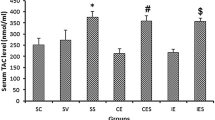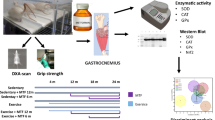Abstract
The role of glutathione (GSH) in myocardial antioxidant defense was investigated in Swiss-Webster mice either performing swim exercise to exhaustion or rested in both the GSH adequate (GSH-A) and GSH deficient (GSH-D) states. GSH deficiency was accomplished by injecting mice with L-buthionine [S,R]sulfoximine (BSO; 2 nmol/kg body wt, i.p.) and providing BSO (20 mM) in drinking water for 12 days. GSH and glutathione disulfide (GSSG) contents in the GSH-D hearts were decreased to 10 and 8%, respectively, of those in the GSH-A mice. This decrease was associated with a significant decline of the total glutathione level in the liver, skeletal muscle and plasma. Myocardial GSH peroxidase and GSH sulfur-transferase activities decreased significantly following GSH deficiency, whereas superoxide dismutase activity was significantly elevated. GSH deficiency did not affect exercise endurance performance. However, exhaustive exercise decreased GSH content in the myocardium of the GSH-A and GSH-D mice by 22 and 44% (p < 0.05), respectively. The GSH:GSSG ratio was not altered significantly following exercise because of a concomitant decrease in GSSG (p < 0.05). γ-Glutamyltranspeptidase activity was significantly increased after exercise, especially in the GSH-D hearts (72%; p < 0.05). GSH content after exercise correlated negatively with exercise time in both GSH-A and GSH-D mice (p < 0.05). These data indicate that GSH is actively used in the myocardium during prolonged exercise at moderate intensity and that GSH deficiency is tolerated by the heart, possibly compensated for by an increased GSH uptake from the plasma.
Similar content being viewed by others
References
Kumar CT, Reddy VK, Plasad M, Thyagaraju K, Reddanna P: Dietary supplementation of vitamin E protects heart tissue from exercise-induced oxidant stress. Mol Cell Biochem 111: 109–115, 1992
Ji LL: Exercise induced oxidative stress in the heart. In: C.K. Sen, L. Packer and O. Hanninen (eds). Exercise and Oxygen Toxicity. Elsevier Science Publishers B.V, Amsterdam, 1994, pp 249–268
Ji LL, Dillon D, Wu E: Myocardial aging: antioxidant enzyme systems and related biochemical properties. Am J Physiol 261: R386-R392, 1991
Powers SK, Criswell D, Lawler J, Martin D, Lieu FK, Ji LL, Herb RA: Rigorous exercise training increases superoxide dismutase activity in ventricular myocardium. Am J Physiol 265: H2094-H2098, 1993
Chance B, Sies H, Boveris A: Hydrogen peroxide metabolism in mammalian organs. Physiol Rev 59: 527–605, 1979
Rajguru SU, Yeargans GS, Siedler NW: Exercise causes oxidative damage to rat skeletal muscle microsomes while increasing ceilular sulfbydryls. Life Sciences 54: 149–157, 1994
Meister A: Glutathione deficiency produced by inhibition of its synthesis, and its reversal; applications in research and therapy. Pharmacol Ther 51: 155–194, 1991
Halliwell B, Gutteridge JMC: Free radicals in Biology and Medicine. Clarendon Press, Oxford, p. 1989
Deneke, SM Fanburg BL: Regulation of cellular glutathione. Am J Physiol 257, L 163-L 173, 1989
Griffith, O Meister A: Glutathione: interorgan translocation, turnover, and metabolism. Natl Acad Sci USA 76: 5606–5610, 1979
Martensson J, Meister A: Mitochondrial damage in muscle occurs after marked deficiency of glutathione and is prevented by giving glutathione monoester. Proc Natl Acad Sci USA 86; 471–475, 1989
Leeuwenburgh C, Ji LL: Glutathione depletion in rested and exercised mice: biochemical consequence and adaptation. Arch Biochem Biophys 316 (2): 941–949, 1995
Pyke S, Lew H, Quintanilha A: Severe depletion in liver glutathione during physical exercise. Biochem Biophys Res Comm 139: 926–931, 1986
Sen CK, Ataley M, Hanninen O: Exercise-induced oxidative stress: glutathione supplementation and deficiency. J Appl Physiol, 77, 2177–2187, 1994
Packer L, Gohil K, DeLumen B, Terblanche SE: A comparative study on the effects of ascorbic acid deficiency and supplementation on endurance and mitochondrial oxidative capacities in various tissues of the guinea pig. Comp Biochem Physiol 8313: 235–240, 1986
Blaustein, MD, Deneke SM, Stolz RI, Baxter D, Healey N, Fanburg BL: Myocardial glutathione deficiency impairs recovery after short periods of ischemia. Circulation, 80, 1449–1457, 1989
Werns SW, Fantone JO, Ventura A, Lucchesi BR: Myocardial glutathione deficiency impairs recovery of isolated blood-perfused hearts after global ischemia. J Mol Cell Cardiol 24: 1215–1220, 1992
Jaeschke H, Wendel A: Diurnal fluctuation and pharmacological alteration of mouse organ glutathione content. Biochem Pharmacol 34: 1029–1033, 1985
Reed DJ, Basson JR, Beatty PW, Brodie, AE, Ellis WW Potter DW: High performance liquid chromatography of nanomol levels of glutathione, glutathione disulfide and related thiols and disulfides. Anal Biochem 106: 55–62, 1980
Ji LL, Fu R: Response of glutathione system and antioxidant enzymes to exhaustive exercise and hydroperoxide. J Appl Physiol 72: 549–554, 1992
Aebi H: Catalase. In: Methods in Enzymology, edited by L Packer Orlando, FL: Academic Press, 1984, Vol 105, pp 121–126
Meister A, Tate SS, Griffith O: Methods in Enzymology Academic Press, San Diego, 1981, pp 237–242
Leeuwenburgh C, Fiebig R, Charsdwaney, Ji LL: Aging and exercise training in skeletal muscle: Response of glutathione and antioxidant enzyme systems. Am J Physiol 267: 439–445, 1994
Seelig G, Meister A: Glutathione biosynthesis; γ-glutamylcysteine synthetase from rat kidney. Methods in Enzymology 113: 379–399, 1985
Uchiyama M, Mihara M: Determination of malondialdehyde precursor in tissues by thiobarbituric acid test. Anal Biochem 86: 271–278, 1978
Blum J, Fridovich I: Inactivation of glutathione peroxidase by superoxide radical. Arch Biochem Biophys 240: 500–508, 1985
Meister A: Glutathione-ascorbic acid antioxidant system in animals. J Biol Chem 269: 9397–9400, 1994
Ishikawa T, Sies H: Cardiac transport of glutathione disulfide and Sconjugate. J Biol Chem 259: 3838–3843, 1984
Sen CK, Rahkila P, Hanninen O: Glutathione metabolism in skeletal muscle derived cells of the L6 line. Acta Physiol Scand 148: 21–26, 1993
Srivastava SK, Beutler E: The transport of oxidized glutathione from human erythrocytes. J Biol Chem 244: 9–16, 1969
Kihlstrom MT: Lipid peroxidation capacity in the myocardium of endurance-trained rats and mice in vitro. Acta Physiol Scand 146: 177–183, 1992
Suzuki M, Katamine S, Tatsumi S: Exercise-Induced enhancement of lipid peroxide metabolism in tissues and their transferense into the brain in rat. J Nutr Sci Vit 29: 141–151, 1983
Author information
Authors and Affiliations
Rights and permissions
About this article
Cite this article
Leeuwenburgh, C., Leichtweis, S., Hollander, J. et al. Effect of acute exercise on glutathione deficient heart. Mol Cell Biochem 156, 17–24 (1996). https://doi.org/10.1007/BF00239314
Received:
Accepted:
Issue Date:
DOI: https://doi.org/10.1007/BF00239314




